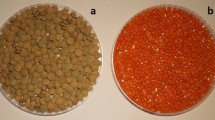Abstract
Selected legume seeds (dry and soaked) including faba beans, peas, chickpeas, soybeans, lentils and common beans containing 8 and 25% moisture, respectively, were subjected to microwave heating, and to a conventional cooking method to determine the heating effect on toxic compounds and protein quality. Trypsin inhibitors, hemagglutinins and available lysine were analyzed, and laboratory rats were used to determine digestibility and protein efficiency ratio (PER). Results indicated that microwaving destroyed trypsin inhibitors to a similar degree to that observed in beans cooked using the conventional method without affecting PER for raw seeds with low antinutrients content (faba beans, peas, chickpeas and lentils). Microwave-heated soaked soybeans had a higher amount of destroyed trypsin inhibitors, along with a higher PER, compared with microwave-heated dry soybeans. Microwave heating of common beans failed to destroy hemagglutinins and trypsin inhibitors, and consequently their digestibility and PER values were poor. Finally it was concluded that microwave heating constitutes an adequate method for destroying hemagglutinins and trypsin inhibitors without affecting protein quality of most legume seeds, except for common beans that despite of this process retained the antinutritional substances.
Similar content being viewed by others
References
Morrow B (1991) The rebirth of legumes. Food Tech 45:96,121.
Liener IE (1962) Toxic factors in edible legumes and their elimination. Am J Clin Nutr 11: 281–298.
Gupta YP (1987) Anti-nutritional and toxic factors in food legumes: A review. Plant Foods Human Nutr 37: 201–228.
Elias LG, Hernandez M, Bressani R (1976) The nutritive value of precooked legume flours processed by different methods. Nutr Rep Int 14: 385–403.
Salunkhe DK (1982) Legumes in human nutrition: Current status and future research. Current Sci 51: 387–394.
Sayeed S, Njaa L (1985) Effect of bangladeshi home cooking procedure on the amino-acid content, trypsin inhibitor activity and in vitro digestibility of some legume seeds. Qual Plant Plant Foods Human Nutr 35: 379–388.
Kabbara SAR, Abbas IR, Scheerens JC, Tinsley AM, Berry JW (1987) Soaking and cooking parameters of tepary beans: effect of cooking time and cooking temperature on hardness and activity of nutritional antagonists. Plant Foods Human Nutr 37: 151–159.
Singh H (1988) Antinutritional factors of chickpea and pigeon pea and their removal by processing. Plant Foods Human Nutr 38: 251–261.
Nielsen SS (1991) Digestibility of legume proteins. Food Tech 45: 112–114.
IFT (1989) Microwave food processing. Food Tech 43: 117–126.
Giese J (1992) Anti-nutritional and toxic factors in food legumes. Food Tech 46: 118–123.
Schlegel W (1992) Commercial pasteurization and sterilization of foods products using microwave technology. Food Tech 46: 62–63.
Rosen CL (1972) Effects of microwave of food related materials. Food Tech 26: 36–39, 55.
Pour-El A, Nelson SO, Peck EE (1981) Biological properties of VHF-and microwave heated soybeans. J Food Sci 466: 880–886.
Hafez YS, Singh G (1983) Effect of microwave heating on nutritional quality of soybeans. Nutr Rep Int 28: 413–421.
Esaka M, Susuki K, Kubota K (1987) Effects of microwave heating on lipoxygenase and trypsin inhibitor activities and water absorption in winged-bean seeds. J Food Sci 52:1738–1739.
Yoshida H, Kajimoto G (1988) Effect of microwave treatment on trypsin inhibitor and molecular species of triglycerides in soybean. J Food Sci 53: 1756–1760.
Sanchez A, Register VD, Blakenship JW, Hunter ChC (1981) Effect of microwave heating of soybean on protein quality. Arch Latinoam Nutr 31: 379–388.
Wang SH, Toledo MCF (1987) Inactivation of soybean lipoxygenase by microwave heating: effect of moisture content and exposure time. J Food Sci 52: 1344–1347.
AOAC (1984) Official Method of Analysis, 14th edn. Washington, DC: Association of Official Analytical Chemists.
Kakade ML, Rackis JJ, McGhee JE, Puski G (1974) Determination of trypsin inhibitor activity of soy products. A collaborative analysis of an improved procedure. Cereal Chem 51: 376–382.
Jaffe WG, Levy A, Gonzalez DI (1974) Isolation and partial characterization of bean phytohemagglutinins. Phytochem 13: 2685–2693.
Carpenter KJ (1960) The estimation of the available lysine in animal protein foods. Biochem J 77: 604–610.
Pellet PL, Young VR (eds) (1980) Nutritional Evaluation of Protein Foods. Tokyo: The United Nations University, World Hunger Programme, Food and Nutrition Bulletin Supplement 4.
Dawson-Saunders B, Trapp RJ (1994) Basic and Clinical Biostatics, 2nd edn. Norwalk, CT: Appleton and Lange.
Grant G, Moore LJ, Mckenzie NH, Stewart JC, Pusztai A (1983) A survey of the nutritional and hemagglutination properties of legume seeds generally available in the UK. Br J Nutr 50: 207–214.
Jaffe WG, Brucher O (1972) Toxicidad y especificidad de diferentes fitohemaglutininas de frijoles. Arch Latinoam Nutr 22: 267–281.
Jaffe WG (1975) Factors affecting the nutritional value of beans. In: Milner M (ed), Nutritional Improvement of Food Legumes by Breeding. New York: Wiley and Sons.
Liener IE (1958) Effect of heat on plant protein. In: Altschul AM (ed), Processed Plant Protein Foodstuffs. New York: Academic Press.
Kadam SS, Smithard RR (1987) Effects of heat treatment on trypsin inhibitor and hemagglutinating activities in winged bean. Plant Foods Human Nutr 37: 151–159.
Hernandez-Infante M, Herrador-Peña G, Sotelo-Lopez A (1979) Nutritive value of two different beans (Phaseolus vulgaris) supplemented with methionine. J Agr Food Chem 27: 965–968.
Bates RP, Knapp FN, Araujo PE (1977) A protein quality of green-mature and sprouted soybeans. J Food Sci 42: 271–272.
Author information
Authors and Affiliations
Rights and permissions
About this article
Cite this article
Hernández-Infante, M., Sousa, V., Montalvo, I. et al. Impact of microwave heating on hemagglutinins, trypsin inhibitors and protein quality of selected legume seeds. Plant Foods Hum Nutr 52, 199–208 (1998). https://doi.org/10.1023/A:1008033610737
Issue Date:
DOI: https://doi.org/10.1023/A:1008033610737




